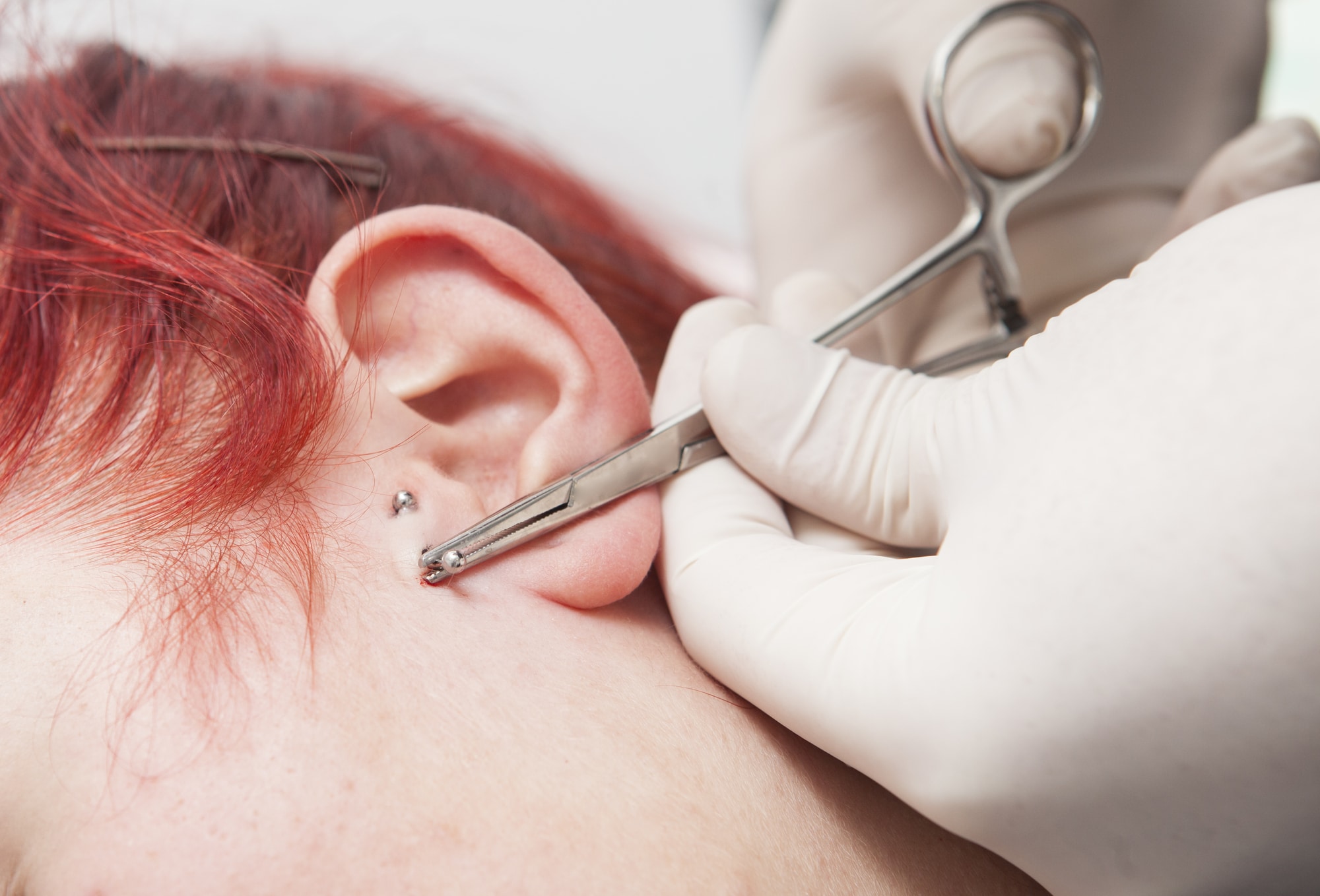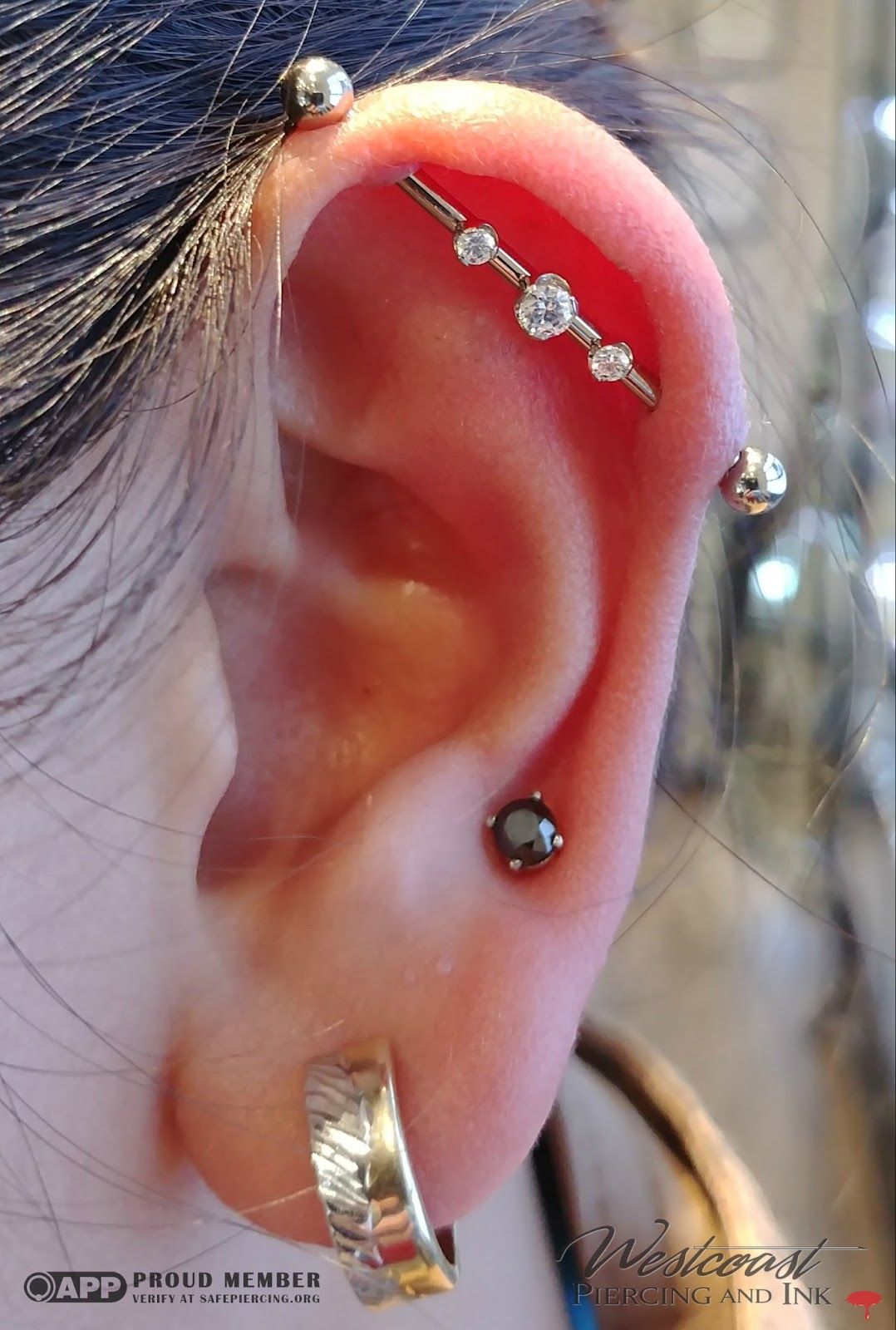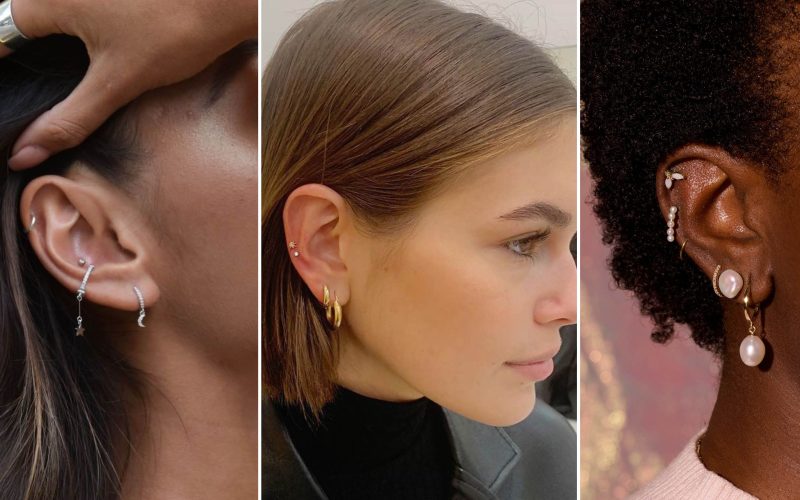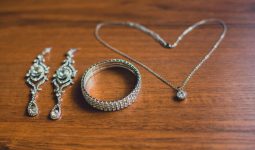Ear piercings can be defined as making a hole in an ear’s lobe or any part of the ear using a sterilized needle so that an earring may be worn in the spot.
There are different types of ear piercings. Ear piercing placement differs depending on the site, the level of pain, and the healing time.
During the old times, people believed the lobe was the only site for ear piercing.
Ear piercings have changed nowadays as people pierce other parts of the ear, like the tragus, helix, daith, and anti-tragus; even the cartilage in the ear is not left out.
Knowing the healing time of the site you want to pierce on the ear is advised before piercing.
Some areas on the ear are harrowing and take time to heal compared to others, as we shall discuss in this article.
So, sit back and explore the different types of ear piercings available.
Different Types of Ear Piercings
1. Tragus Piercing

The tragus is a small piece of cartilage present at the entrance of the ear canal. It is positioned closest to the face and is slightly triangular.
Piercing the tragus is stylish and attractive. It, however, has its cons, as the tragus is a delicate area. The piercing varies in size and shape depending on your preference.
The next factor to consider after the site is the healing time and pain threshold when considering ear piercings.
The tragus piercing is pretty painful and takes time, specifically months, to heal. Everyone’s pain threshold differs, so some might not feel the same pain.
The tragus compliments an earring stack nicely, and it suits a simple stud and a small hoop resting within the center of the ear. The tragus piercing is a beautiful type of ear piercing.
2. Rook Piercing

The rook is another part of the external ear located above the tragus on the ridge between the inner and outer conch.
Rook piercing is another ear piercing that sits horizontally through the cartilage fold that separates the ear’s inner and outer parts.
This piercing type differs from the other ear piercings that span from front to back. This piercing passes from the underside to the top of the ridge, a less popular placement, making your curated ear stand out.
This piercing is also on the cartilage, and it may be painful. The healing time takes about 6-12 months, depending on your anatomy. Piercing rings or curved barbells go well on rook piercings.
A barbell is a metal bar with balls on the ends, and one of the balls is removable. Seamless hoops, clickers, and captive bead rings are also excellent choices.
3. Snug Piercing
These different types of ear piercings are placed horizontally through the inner rim of the cartilage above the anti-tragus. The snug gets its name from the “hug” in the ears’ folds.
Some individuals consider this piercing the most painful because of its location. Because of their tight placement, curved barbells are a fantastic choice for jewelry worn on a snug piercing.
4. Anti-tragus Piercing
Anti-tragus is a vertical lip of cartilage located above the earlobe and opposite the tragus, hence the name. This type of ear piercing varies between individuals.
Some can get the piercing, while some can not. Individuals with prominent anti-tragus, a sensitive part of the ear, are the best candidates for this type of piercing.
The area will be sensitive for up to a year after the hole has been made, so earphones, headphones, or earbuds cannot be used for some time.
5. Standard Lobe Piercing (The Original!)
Standard lobe piercing is also known as the original. It is so-called because it is the first piercing of most individuals if not all. Most people get this piercing as a child before planning more placements.
It ranks low on the pain scale because most people won’t feel it. This piercing is the most comfortable and approachable for someone who has not had any ear piercings before. They take about 2 months to heal.
Double-lobe piercings are beautiful for individuals who want to ease their way into getting another piercing.
When done well, the standard lobe piercing is a beautiful type of piercing.
Small rings/ hoops, nickel-free earrings, and studs are advised for easy cleaning, healing, and avoiding infections.
6. Transverse Lobe Piercing
The transverse lobe piercing is another of the different types of ear piercings that are available to explore. It goes horizontally through the lobe instead of from front to back.
The ear shape determines how the piercing will be done. If the ea lobes are attached, the piercing may appear curved. If the earlobes are detached, the piercing might be straight.
Due to its location, it might not be excruciating as it is still on the lobe. It takes about 2 months to heal, but some might take up to 10 months, depending on the skin type. Barbell is a fantastic choice for this piercing as it fits it well.
7. Helix Piercing
The helix is another part of the external ear. It ranges from the superior attachment of the ear on the root to the end of the cartilage of the earlobe. The helix is cartilage, and any piercing done on a cartilage is usually painful.
The cartilage is thinner in the upper ear, and a helix piercing is a cartilage placement on the upper rim of the ear. This piercing tends to be the least painful of all cartilage piercings.
This piercing takes about 3-6 months to heal. Captive bead rings, seamless rings, labret studs, classic cartilage hoops, and celestial crystal threaded flat black earrings are all excellent earrings to style with a helix piercing.
8. Daith Piercing
Daith piercing has been known to have a historical origin. The word daith comes from Hebrew, which translates to “knowledge.” She named it “da’at” because the piercer must be extremely smart to figure out how to do the piercing.
People also believe this piercing is good for curing migraines because it is located on an acupressure point, but there is no scientific evidence. The technique is quite advanced, requiring a special needle and a piercing expert.
The pain feels more like a dull pressure and continues over time. However, everyone has a different pain tolerance, so it differs from person to person. Daith piercing takes six to nine months to heal completely. The most common earrings for this type of piercing are hoops and curved barbells.
9. Auricle Piercing
The auricle is located on the ear’s outer portion between the lobe and the helix. This type of piercing sits halfway up the ear across from the tragus. Auricle piercing is also known as rim piercing, as it is found on the rim of the cartilage.
This piercing is located on the cartilage, which is expected to be painful. However, the cartilage in that area is relatively thin, so the pain level is mild compared to other cartilage in the ear. Depending on the individual’s anatomy, auricle piercing takes about three to six months to heal completely.
Classic loops are a great choice of earrings for this type of piercing. Simple studs, barbells, and labret studs are also great picks.
10. Conch Piercing
The conch is the inner cup of the ear, located parallel to the daith. It is an area of cartilage found in the middle of the ear near the opening of the ear canal.
Conch piercings provide the most space for different earrings and styling options, making them one of the most desirable placements.
Due to their shape and the thickness of the cartilage in this part of the ear, the pain level is a little high compared to other parts of the ear.
The healing process takes about three to nine months. To avoid irritation, lightweight and small earrings are the best choices. Labret studs and conch studs are excellent adornments for this piercing.
11. Orbital Piercing
When discussing the different types of ear piercings, orbital piercing is a special type. Orbital piercing combines two ear piercings in the earlobes connected by one piece of jewelry. It is usually located in the helix region of the ear.
It can be made on the earlobe or the lower portion of the outer ear. Depending on its placement, the pain level ranges from mild to moderate.
The healing period lasts two to three months, depending on the individual. Dainty hoops and ball closure rings are excellent earrings for orbital piercings.
12. Flat Piercing
This type of piercing is located on the flat area below the ear’s upper outer rim of the ear. Multiple flat piercings allow ear constellation trends and fashion sense; however, one flat piercing is advised.
The pain level might be high due to its location on a thick cartilage. The placement takes about three to ten months to heal. Studs of flat-back earrings are beautiful earrings to style this piercing.
This type of piercing provides a large area for fashion and unique placement. It looks fashionable on its own and when combined with other piercings.
13. Forward Helix Piercing
This piercing is located directly above the tragus and opposite the hairline. Multiple piercings can be placed in this area. The pain level ranges from moderate to high. The wound recovery time takes about three to nine months.
This piercing is more tricky than the typical helix piercing, as the placement must be aligned with the ear. Flat-back stud earrings are an excellent choice for this type of piercing.
14. Inner Conch Piercing
Inner conch piercing is located through the middle shell of the ear, which is the thickest piece of the ear’s cartilage. It goes deeper than ordinary conch piercing, closer to the ear canal. One must be cautious with this piercing to avoid irritation and infection.
Studs and bars are great for this piercing as they are comfortable and small. Flat-back studs and barbells are also fantastic choices for inner conch piercings.
14. Industrial Piercing

Industrial piercing refers to two cartilage piercings on the upper ear connected with a barbell.
This type of piercing depends on the shape of the ear and can be done with any two holes in the upper ear.
It has a high pain level, involving two thick cartilages and two piercings simultaneously.
The wound recovery time is around seven to ten months, but the healing process could take up to a year. They tend to get irritated easily, so aftercare is essential.
15. High Lobe Piercing
One fantastic type of ear piercing is a high-lobe piercing. It is a fun way of styling the lobe, and since the lobe is fleshy, the pain level is relatively low.
They are suitable for making a fashionable way out of a poorly placed piercing that was earlier done.
Aftercare is crucial to avoid irritation and infection and shouldn’t be ignored. Studs are classics for this piercing as they look attractive in a higher lobe piercing.
16. Stacked Lobe Piercing
Stacked lobe piercing has multiple piercings at different heights on the lobes. It differs from high lobes piercing because they are located directly on top of the lobes. Stacked lobe piercing is located anywhere on the lobes.
Any piercing located on the lobes is mildly painful compared to other types of placements. The pain level is mild, and recovery takes three to six months to heal fully. Tiny studs are recommended to style this piercing for comfort.
17. Outer Conch Piercing
Outer conch piercing is another piercing among the different types of ear piercings to rock. This piercing allows a ring to go around the outer edge of the ear’s cartilage. The cartilage in the outer conch is thicker and more rigid than most parts of the ear.
The pain level is higher than in other parts. Labret studs, barbells, flat-back studs, and hoops are classic picks for an outer conch piercing. Small and lightweight earrings are advised to avoid irritation.
Similar to the inner conch, this type of piercing also goes through the same area of cartilage but the lower part. Do not sleep on the side of the new piercing until it is fully healed.
Conclusion
Ear piercings are a fashionable way to style and enhance the ear. There are many different types of ear piercings available, which you can explore.
The healing time and pain level depend on the placement location and the individual’s sensitivity to pain.
The standard lobe piercing is the original because that is most people’s first piercing. However, it can be made fashionable: the stacked lobe piercing and the high lobe piercing.
The different parts of the outer ear—from the helix, tragus, snug, anti-tragus, and conch (inner and outer) to daith and rook—can be pierced and styled beautifully.
There is a piercing and an earring for every part of the outer ear. The different earrings for the piercings depend on the site of the placement.
Please go ahead if you found this article helpful on the different types of ear piercings available and wish to explore them. Then, refer it to your friends so they know about the different ear piercings available!








